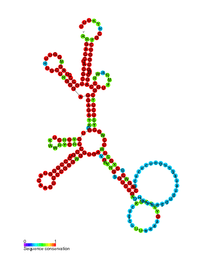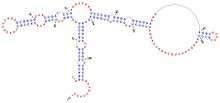Epstein–Barr virus-encoded small RNAs
The Epstein–Barr virus-encoded small RNAs (EBERs) are small non-coding RNAs localized in the nucleus of human cells infected with Epstein–Barr virus (EBV). First discovered in 1981, EBERs are the most abundant RNAs present in infected cells.[1] EBERs interact with several host proteins to form ribonucleoprotein (RNP) complexes. Although a precise function for EBERs remains elusive, roles in transformation and oncogenesis are proposed.
| EBER1 | |
|---|---|
 Conserved secondary structure of EBER1. | |
| Identifiers | |
| Symbol | EBER1 |
| Rfam | RF01789 |
| Other data | |
| RNA type | Gene |
| Domain(s) | Epstein–Barr virus |
| PDB structures | PDBe |
Background
EBER1 and EBER2 are short, 167 and 172 nucleotides in length respectively, nuclear-enriched non-coding RNAs. These two RNAs are transcribed by the host's RNA polymerase III during latent infection of EBV.[2][3]
EBERs 1 and 2 can be deleted from the viral genome without noticeable phenotypic changes, though this has never been found deleted in nature.[2] EBER expression alone can induce tumours in severe combined immunodeficient mice.[4][5]
EBER1
EBER1 associates with human ribosomal protein L22[6] and causes this protein to move from the nucleolus to the nucleoplasm.[7] EBER1 also specifically interacts with at least three host hnRNPs (A1, A2/B1 and D/AUF1).[8]
EBER2

Similar to EBER1, EBER2 is very highly expressed in latently infected cells. Unlike EBER1, the sequence of EBER2 is less conserved in related herpesviruses (~50% conservation). However, the secondary structure of EBER2 is highly conserved (see Figure 1). EBER2 is only known to bind cellular proteins (specifically, the La domain) at its terminal stretch of repeated uridines; however, it is believed that the other features of EBER2, particularly its two long and highly conserved stem-loops, may also serve as binding sites for yet unknown proteins.[9]
References
- Lerner MR, Andrews NC, Miller G, Steitz JA (February 1981). "Two small RNAs encoded by Epstein-Barr virus and complexed with protein are precipitated by antibodies from patients with systemic lupus erythematosus". Proceedings of the National Academy of Sciences of the United States of America. 78 (2): 805–809. doi:10.1073/pnas.78.2.805. PMC 319891. PMID 6262773.
- Conrad NK, Fok V, Cazalla D, Borah S, Steitz JA (2006). "The challenge of viral snRNPs". Cold Spring Harbor Symposia on Quantitative Biology. 71: 377–384. doi:10.1101/sqb.2006.71.057. PMID 17381320.
- Moss WN, Lee N, Pimienta G, Steitz JA (2014). "RNA families in Epstein-Barr virus". RNA Biology. 11 (1): 10–17. doi:10.4161/rna.27488. PMC 3929418. PMID 24441309.
- Komano J, Maruo S, Kurozumi K, Oda T, Takada K (December 1999). "Oncogenic role of Epstein-Barr virus-encoded RNAs in Burkitt's lymphoma cell line Akata". Journal of Virology. 73 (12): 9827–9831. PMC 113031. PMID 10559294.
- Yamamoto N, Takizawa T, Iwanaga Y, Shimizu N, Yamamoto N (November 2000). "Malignant transformation of B lymphoma cell line BJAB by Epstein-Barr virus-encoded small RNAs". FEBS Letters. 484 (2): 153–158. doi:10.1016/S0014-5793(00)02145-1. PMID 11068051.
- Fok V, Mitton-Fry RM, Grech A, Steitz JA (May 2006). "Multiple domains of EBER 1, an Epstein-Barr virus noncoding RNA, recruit human ribosomal protein L22". RNA. 12 (5): 872–882. doi:10.1261/rna.2339606. PMC 1440895. PMID 16556938.
- Toczyski DP, Matera AG, Ward DC, Steitz JA (April 1994). "The Epstein-Barr virus (EBV) small RNA EBER1 binds and relocalizes ribosomal protein L22 in EBV-infected human B lymphocytes". Proceedings of the National Academy of Sciences of the United States of America. 91 (8): 3463–3467. doi:10.1073/pnas.91.8.3463. PMC 43597. PMID 8159770.
- Lee N, Pimienta G, Steitz JA (November 2012). "AUF1/hnRNP D is a novel protein partner of the EBER1 noncoding RNA of Epstein-Barr virus". RNA. 18 (11): 2073–2082. doi:10.1261/rna.034900.112. PMC 3479396. PMID 23012480.
- Moss WN, Lee N, Pimienta G, Steitz JA (20 Dec 2013). "RNA families in Epstein-Barr virus". RNA Biology. 11 (1): 10–17. doi:10.4161/rna.27488. PMC 3929418. PMID 24441309.
External links
- Page for Human herpesvirus 1 small nucleolar RNA at Rfam
- Page for EBER1 at Rfam
- Page for v-snoRNA1 at Rfam
- Page for IRES_EBNA at Rfam
- Epstein–Barr virus stable intronic sequence RNAs